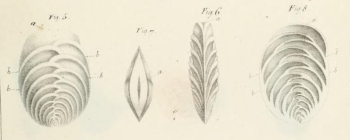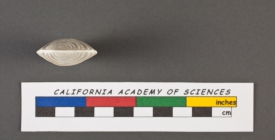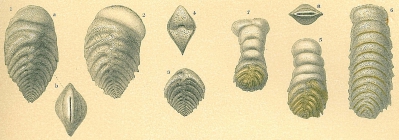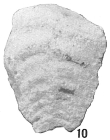WoRMS taxon details
Vulvulina d'Orbigny, 1826
112395 (urn:lsid:marinespecies.org:taxname:112395)
accepted
Genus
Vulvulina capreolus d'Orbigny, 1826 accepted as Vulvulina pennatula (Batsch, 1791) (type by subsequent designation)
Schizophora Reuss, 1861 · unaccepted (Subjective junior synonym in...)
Subjective junior synonym in opinion of Loeblich and Tappan (1987)
Trigenerina Schubert, 1902 · unaccepted (Subjective junior synonym in...)
Subjective junior synonym in opinion of Loeblich and Tappan (1987)
Venilina Gümbel, 1870 · unaccepted (Subjective junior synonym in...)
Subjective junior synonym in opinion of Loeblich and Tappan (1987)
- Species Vulvulina arenacea (Bagg, 1908)
- Species Vulvulina garciai Zernetskij & Mel'nik, 1975
- Species Vulvulina jarvisi Cushman, 1932
- Species Vulvulina pacifica Cushman, 1932
- Species Vulvulina pennatula (Batsch, 1791)
- Species Vulvulina pupa d'Orbigny, 1826
- Species Vulvulina alata Seguenza, 1862 accepted as Bolivina alata (Seguenza, 1862) (Opinion of Cushman (1937))
- Species Vulvulina capreolus d'Orbigny, 1826 accepted as Vulvulina pennatula (Batsch, 1791) (Synonym)
- Species Vulvulina dermouti Boomgaart, 1949 accepted as Semivulvulina dermouti (Boomgaart, 1949)
- Species Vulvulina elegans d'Orbigny, 1826 accepted as Vulvulina pennatula (Batsch, 1791)
- Species Vulvulina gramen d'Orbigny, 1839 accepted as Bolivina gramen (d'Orbigny, 1839)
- Species Vulvulina sinensis Zheng, 1988 accepted as Bigenerinoides sinensis (Zheng, 1988) (Type species of Bigenerinoides)
marine, brackish, fresh, terrestrial
recent + fossil
Orbigny, A. D. d'. (1826). Tableau méthodique de la classe des Céphalopodes. <em>Annales des Sciences Naturelles.</em> vol. 7: 96-169, 245-314., available online at http://biodiversitylibrary.org/page/5753959
page(s): p. 264 [details]
page(s): p. 264 [details]
Hayward, B.W.; Le Coze, F.; Vachard, D.; Gross, O. (2024). World Foraminifera Database. Vulvulina d'Orbigny, 1826. Accessed through: World Register of Marine Species at: https://www.marinespecies.org/aphia.php?p=taxdetails&id=112395 on 2024-04-18
Date
action
by
![]() The webpage text is licensed under a Creative Commons Attribution 4.0 License
The webpage text is licensed under a Creative Commons Attribution 4.0 License
original description
Orbigny, A. D. d'. (1826). Tableau méthodique de la classe des Céphalopodes. <em>Annales des Sciences Naturelles.</em> vol. 7: 96-169, 245-314., available online at http://biodiversitylibrary.org/page/5753959
page(s): p. 264 [details]
original description (of Venilina Gümbel, 1870) Gümbel C. W., von. (1870). Beiträge zur Foraminiferenfauna der nordalpinen, älteren Eocängebilde oder der Kressenberger Nummulitenschichten. <em>Abhandlungen der Mathematisch-Physikalischen Klasse der Königlich Bayerischen Akademie der Wissenschaften.</em> 10(2)[1868]: 581-730., available online at https://www.biodiversitylibrary.org/page/35524814
page(s): p. 648 [details]
original description (of Schizophora Reuss, 1861) Reuss, A. E. (1861). Kurze Notiz über eine neue Foraminiferengattung Schizophora. <em>Sitzungsberichte der Königlichen Böhmischen Gesellschaft der Wissenschaften in Prag, Mathematisch-Naturwissenschaftliche Classe.</em> 1861(2):12-13., available online at https://biodiversitylibrary.org/page/43122143
page(s): p; 12 [details]
original description (of Trigenerina Schubert, 1902) Schubert, R. J. (1902). Neue und interessante Foraminiferen aus dem Südtiroler Alttertiär. <em>Beiträge zur Paläontologie und Geologie Österreich-Ungarns und des Orients.</em> 14 (1/2): 9-26., available online at https://www.biodiversitylibrary.org/page/15265311 [details]
basis of record Gross, O. (2001). Foraminifera, <B><I>in</I></B>: Costello, M.J. <i>et al.</i> (Ed.) (2001). <i>European register of marine species: a check-list of the marine species in Europe and a bibliography of guides to their identification. Collection Patrimoines Naturels,</i> 50: pp. 60-75 (look up in IMIS) [details]
additional source Neave, Sheffield Airey. (1939-1996). Nomenclator Zoologicus vol. 1-10 Online. <em>[Online Nomenclator Zoologicus at Checklistbank. Ubio link has gone].</em> , available online at https://www.checklistbank.org/dataset/126539/about [details]
page(s): p. 264 [details]
original description (of Venilina Gümbel, 1870) Gümbel C. W., von. (1870). Beiträge zur Foraminiferenfauna der nordalpinen, älteren Eocängebilde oder der Kressenberger Nummulitenschichten. <em>Abhandlungen der Mathematisch-Physikalischen Klasse der Königlich Bayerischen Akademie der Wissenschaften.</em> 10(2)[1868]: 581-730., available online at https://www.biodiversitylibrary.org/page/35524814
page(s): p. 648 [details]
original description (of Schizophora Reuss, 1861) Reuss, A. E. (1861). Kurze Notiz über eine neue Foraminiferengattung Schizophora. <em>Sitzungsberichte der Königlichen Böhmischen Gesellschaft der Wissenschaften in Prag, Mathematisch-Naturwissenschaftliche Classe.</em> 1861(2):12-13., available online at https://biodiversitylibrary.org/page/43122143
page(s): p; 12 [details]
original description (of Trigenerina Schubert, 1902) Schubert, R. J. (1902). Neue und interessante Foraminiferen aus dem Südtiroler Alttertiär. <em>Beiträge zur Paläontologie und Geologie Österreich-Ungarns und des Orients.</em> 14 (1/2): 9-26., available online at https://www.biodiversitylibrary.org/page/15265311 [details]
basis of record Gross, O. (2001). Foraminifera, <B><I>in</I></B>: Costello, M.J. <i>et al.</i> (Ed.) (2001). <i>European register of marine species: a check-list of the marine species in Europe and a bibliography of guides to their identification. Collection Patrimoines Naturels,</i> 50: pp. 60-75 (look up in IMIS) [details]
additional source Neave, Sheffield Airey. (1939-1996). Nomenclator Zoologicus vol. 1-10 Online. <em>[Online Nomenclator Zoologicus at Checklistbank. Ubio link has gone].</em> , available online at https://www.checklistbank.org/dataset/126539/about [details]
 Present
Present  Inaccurate
Inaccurate  Introduced: alien
Introduced: alien  Containing type locality
Containing type locality
From editor or global species database
Diagnosis Test free, flaring or broad and elongate, lozenge shaped to rhomboidal in section, margins sharply angled, early portion planispirally coiled at least in the microspheric generation, later with very broad and low, biserially arranged chambers that are strongly curved backwards toward the proloculus, and in welldeveloped specimens may be uniserial in the final stage, sutures distinct; wall finely agglutinated, surface smoothly finished; aperture a broad low interiomarginal arch in the early stage, later becoming terminal, a narrow elongate slit. ?U. Cretaceous (Campanian); Paleocene to Holocene; cosmopolitan. (Loeblich & Tappan, 1987, Foraminiferal Genera and Their Classification) [details]









